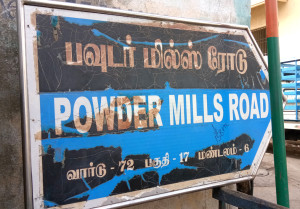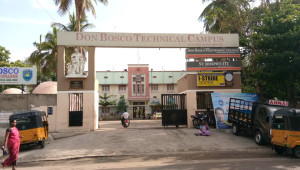Registered with the Registrar of Newspapers for India under R.N.I 53640/91
Vol. XXIX No. 6, July 1-16, 2019
When Perambur made Gunpowder
- Sriram V

OLD |

NEW |
|
Our Old is the signboard that records the fact that a gunpowder mill once functioned in Perambur. The New is the Don Bosco Technical campus that came up on the same site in 1951. More in Lost Landmarks. Photo credits: S. Joseph. |
|
Powder Mill Road, Perambur, is a thoroughfare that connects Pulianthope and the Don Bosco campus. In terms of distance it is not much but the name is indicative of a history long forgotten, for this was where the East India Company made gunpowder for quite some time.
This was an essential commodity for the EIC and the records in Madras are replete with references to how and where it was made. The first mill was in Fort St George itself and let us not forget that among the first three men who came to negotiate for Madras from the Nayak of Poonamallee was Nagabathan, the gunpowder maker. A second one was built in old Black Town. By the early 18th century, the facility was shifted to the Island where it changed location at least once. To quote HD Love, “although a new and costly Powder House was under construction on the Island from 1728 to 1732, it appears to have been employed as a magazine, the old building shown on Thomas Pitt’s map continuing to be utilised for manufacture. In 1738 the latter structure was reported to be past repair and the Government resolved to erect a new powder mill at a greater distance from the Fort.”
The Paymaster and Storekeeper of the Powder House were entrusted with the task of finding a new location and they zeroed in on the “Northwest corner of the Island, between the roads leading to Egmore and Chindadre pettah.” Emphasis was given on the fact that the structure was at considerable distance from both the thoroughfares and so there would be no loss of civilian life in the event of an accident. The new mill was completed by 1738. Along came the French in 1746 and among their first acts was to destroy the mill. The English returned in 1749 and built a new mill at the Egmore Redoubt (see Lost Landmarks, MM, August 1, 2018) and possibly to rub it in the face of the French did so with materials salvaged from the demolished Capuchin Church of St Andrews in the Fort, whose fathers were suspected of having colluded with the invaders.
In 1758, the invading French destroyed the Egmore mill but were not successful in capturing Madras. The victorious English rebuilt the mill, but even while work was in progress, a terrific explosion destroyed much of it. Work continued nevertheless and was completed by 1762, only to have a cyclone take away the roof in 1768. By 1799, there was talk of a new mill, to be constructed near modern Black Town, and that was how Perambur was chosen.
The new mill was constructed exactly as per the plan for the old one on the Island and since the records of the latter have survived, we have a clear idea as to what the layout in Perambur was like – “twenty separate chambers and open areas for storing, refining, weighing and mixing the ingredients, and for corning and drying the powder.” The work was completed in 1802 and from then till 1875, this was the facility that supplied the Madras army with gunpowder. That year, with gunpowder making becoming centralised at Kamptee, the factory was closed. It reopened soon thereafter, this time as a Harness and Saddle Factory. It remained in operation till the early 1900s, when it was closed down, the making of such equine accessories being centralised in Jubbulpore.
But like the legendary cat, this space was to have many lives. The Department of Fisheries, begun at the instance of (later Sir) Frederick Nicholson, ICS became interested in the place for breeding larvicidal and other kinds of fish. The brickfields in the neighbourhood (Brick Kiln Road, now invariably written as Brick ‘Klin’ Road is nearby and promises yet another lost landmark) were converted into ponds for the purpose.
Lt Col. HA Newell, that indefatigable traveller and writer, visited the erstwhile Powder Mill property in 1919 and left behind an account:
“Notwithstanding its two tall chimneys nothing could be less like the modern conception of a factory than the drowsy old world pleasaunce at Perambore, still known as the Powder Mills. It dates from the latter part of the 18th century, and is enclosed by low walls, and shaded by a variety of trees, conspicuous amid which is the great Baobab (Adansonia digitala) from Senegal, its huge suede covered pods filled with a variety of tamarind greedily devoured by squirrels. Entrance is through a gate to south. The interior contains numerous godowns, a number of widely separated bombproof buildings, and some large masonry tanks, where big pink lotus float upon opaque green water. To north, a broken stone bridge partly spans a channel. Originally it led to a widespread bombproof edifice, over the arched door of which is the sign “Government Fisheries.”
The Department of Fisheries continued here till 1936. During the years when the rains failed, the Perambur brick kilns turned lakes ran dry and that necessitated shifting the fish. As early as 1931 plans were afoot to move the Fisheries to nearer a more permanent water body. In 1936, the army asked the Fisheries to vacate, as it decided to sell the Powder Mills property and the latter relocated to near the Spur Tank, Chetput, where they still remain.
It is not clear as to whether the army did manage to sell the property. But in late 1940s, when the Salesian Brothers were looking for a space to set up their St Joseph’s Industrial Training Centre, they zeroed in on what was still known as the Harness and Saddle Factory premises as a suitable location. The Brotherhood had just purchased a piece of land in the new colony of Shenoy Nagar but Archbishop Mathias was of the view that such a facility needed to be near the northern end of the city, close to the industrial establishments. The Government was approached and a swap was agreed to, with the Brotherhood giving up its land in west Madras for the old Powder Mill/Harness and Saddle Factory space. By 1951, the first workshop had come up on the site.
The St Joseph’s Industrial Training Centre and Don Bosco continue to function from the location even today. The road from Pulianthope is still known as Powder Mills Road. Forgotten today however is Harness and Saddle Factory Road, a thoroughfare that branched off to the right from Powder Mills Road. That was a name that survived till at least the 1970s. Close by is Perambur Barracks Road, recalling another army presence but that is a story for a later column.


Wanting to know about perambur barracks..many thanks